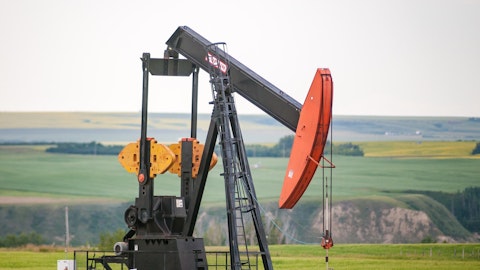We have some experience over 10, 11 years ago where we spent more on strategic capital and then and it was sort of difficult to manage. And so we, as an organization, we decided that we’re going to live within a sort of $1 billion on the upside of strategic capital. Since COVID, we’ve been at about $0.5 billion, and that’s our guidance right now. And we feel like that’s a pretty good number year-in and year-out that we’re going to steward around that we’ll that there’ll be enough projects, whether they’re in refining or transportation or our renewable platforms that all meet and work through our gated process to meet our return thresholds.
Ryan Todd: Okay. Thanks.
Operator: Thank you. The next question is coming from Paul Cheng of Scotiabank. Please go ahead,
Paul Cheng: Hey guys, good morning. I just don’t know whether this will be Lane or Gary. If we’re looking at octane last year that was very strong. If this year that I think a lot of people expect because after last year, the global gasoline demand growth rate probably will slow down China is definitely slowing down. And I think U.S. may even go into a structural because if that will be the case, how you expect the octane lending is going to look like? And what — how that impact or what kind of impact is on your financial result will be? That’s the first question.
Gary Simmons: Okay. Yeah. So I would say a couple of things on octane. Certainly, the incremental crude barrel that’s been coming on to the market has been a light sweet barrel, which has created more naphta yield coming on to the market. And with pet-chem demand being somewhat down, that incremental barrel of naphta that’s being produced is trying to find its way into the gasoline pool. And so what that does is it really causes octanes and naphthas to trade at an inverse when naphtha gets long, naphtha gets weak and then octane starts to trade at a premium. So you can try to blend that naphtha barrel into the gasoline pool. I don’t know that we see that being significantly different this year. The one thing I would tell that I’ve already mentioned, if there’s a prolonged — if there’s a prolonged outage in Russia at the refinery that was hit by the drone attack and there’s less naphtha out on the market.
That could tell you that octanes tend to be a little bit weaker this year. But absent that, I don’t see any fundamental differences in the naphtha where octane markets. Greg, I don’t know if you have anything?
Greg Bram: I agree.
Paul Cheng: And Gary, are you guys net long or balanced on octane?
Gary Simmons: It varies. I would say we’re fairly balanced on octane. We’re long naphtha, so you can always soak up octane that way. But overall, in octane, I’d say fairly balanced.
Paul Cheng: All right. And Gary, Greg, that you guys have a marketing operation in Mexico and in the Caribbean. In Mexico. Any insight how does the local demand look like?
Gary Simmons: Yeah. So our business there continues to grow very, very nicely. Year-over-year, our volumes were up 16% in Mexico. We now have 250 branded sites, which was the largest growing brand in Mexico. I think the big change for this year is in the second quarter of this year, we anticipate the terminal that we’ll use in Northern Mexico and Altamira will start up, it will allow us to be more competitive in that region, which we would expect us to then be able to continue the growth that we’ve seen.
Paul Cheng: How about outside your operation, but that the market as a whole, do you see the gasoline market in Mexico is growing or that is maybe a little bit pullback?
Gary Simmons: Yeah. So our view is Mexico basically recovered last year to pre-COVID levels. And our expectation is you’ll see — continue to see good growth in the gasoline market in Mexico.
Paul Cheng: Okay. Thank you.
Operator: The next question is coming from Joe Laetsch of Morgan Stanley. Please go ahead.
Joe Laetsch: Hey, team. Good morning. And thanks for my questions. So I wanted to start off going back to an earlier point, you mentioned some of the cold weather on the Gulf Coast in the past couple of weeks. Were there any material impacts to operations or crude and product price dislocations that we should be mindful of for the first quarter?
Gary Simmons: No. I would tell you, we had some small operational issues, boiler trips, heater trips, but nothing that’s going to materially impact the quarter and we still feel like the throughput guidance that we’ve given holds.
Joe Laetsch: Great, thanks. And, then shifting to renewable diesel. So volumes averaged above nameplate capacity for the year, which is good to see. It seems like a consistent theme about performance there. Any reason why we shouldn’t expect a similar level of outperformance in 2024, such as turnarounds or anything?
Eric Fisher: Yeah. I think we kept the guidance at the $1.2 billion. We’ve got a couple of catch changes this year. And obviously, when we convert to staff, there’s — there could be a change in capacity because we do have to run the unit a little harder in that mode. So we’re not sure what capacity will look like to that until we get the project on the ground and start it up. So I think this time next year, we’ll have an outlook of what our capacity guidance will be whether it’s up or down.
Joe Laetsch : Got it. That makes sense. Thank you.
Operator: Thank you. The next question is coming from Jason Gabelman of TD Cowen. Please go ahead.
Jason Gabelman: Yeah. Hi, good morning. Thanks for taking my questions. The first one is on refining OpEx. And I think the market has been less focused on that metric in recent years, just given all of the strength in the margins but perhaps it becomes a bit more of a focus as margins may be normalized here to some extent. And looking at your system, I think historically, you were at $3.50 per barrel refining OpEx. This year, you were — I think, around $450 million a barrel at a similar Henry Hub price to historical levels. So just wondering what has been driving that higher OpEx this year versus kind of the pre-COVID level and if you expect it to stay at this higher rate or to come back down?
Greg Bram: Hey, Jason, this is Greg. So one of the things that’s probably most notable when you think over that period has been electricity prices that not so much natural gas, but on the power side, A lot of the places where we operate have seen power costs, particularly in the summer, be quite a bit higher than we’d seen historically. So that’s a part of it. The other part that thinking back over that time frame would also be more recently, some cost inflation pressure, and we’ve talked about that a few times before. That seems to be easing. So that’s something we’re working on to rein back in with our suppliers and folks that we worked with.
Lane Riggs: Is there Jason, this is Lane. I will say still the lowest cost guide, and we work on this like you cannot imagine you should know that as an organization, we’re committed to making sure that we are the best in class with expenses.
Jason Gabelman: Yeah. No, we carefully said that is there any expectation to get back down below $4 or is this kind of $4.50 range we should think about moving forward? Yeah, I’m on cue.
Lane Riggs: We’ll have a look at the numbers. I mean part of the other thing that really drives this in our throughput through even though we have what we would characterize as a variable and fixed cost, we run in through our expenses, most refining expenses are in large part six. So the more barrels we run, the better that metric work. And so you really got to — the best time of the year to look at that and to really understand that as sort of third quarter, essentially. That’s really when you’re seeing the system. Normally, we have the signal to run the highest, both things are online and the cost structures are where they are. So it’s the best time to get an understanding of where the base OpEx is for the system.
Jason Gabelman: Got it. My other question is on the refining growth CapEx, and you rattled off a bunch of what seems like quick-hit projects that clear your return hurdles is what — is there a way you could kind of frame these projects together in terms of potential improvement to capture and kind of whatever stable margin environment, you would evaluate that on or any type of way you could frame the potential upside from these projects? Or is it alternatively just keeping capture maybe stable and enabling flexibility to keep capture stable? Thanks.





